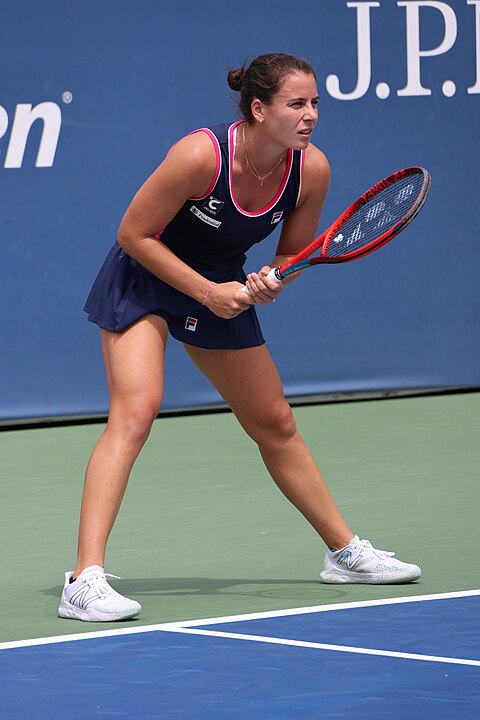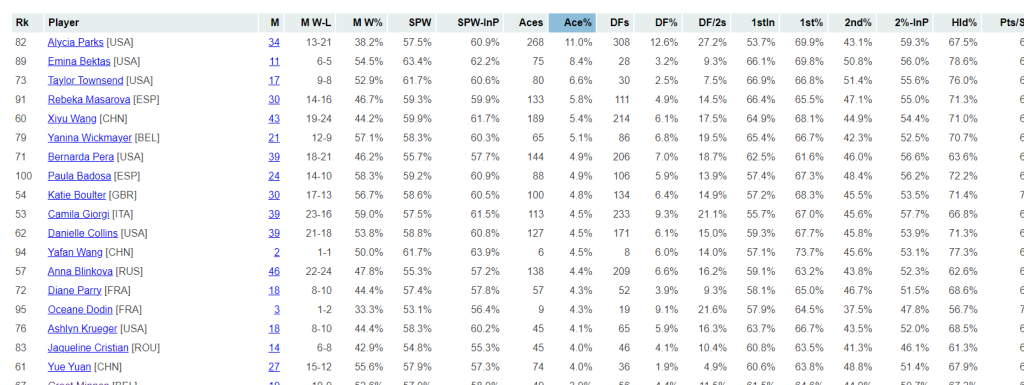Also today: New stat leaderboards

When Emma Navarro beat Elise Mertens for her first WTA title in Hobart on Saturday, it was only part of a natural progression. For more than a year now, she has shown a knack for winning, regardless of level, surface, or just about anything else. While most fans still don’t know her name, she’s up to 26th in the official rankings and 22nd on the Elo list.
The former collegiate champion–winner of the national title as a Virginia Cavalier in 2021–started her 2023 campaign just inside the top 150. She arrived at the brink of the top 100 with back-to-back ITF titles on clay in April, then cracked the top 60 with a grass-court final in Ilkley. Her first top-ten win came in September on hard courts, against Maria Sakkari in San Diego, and after a busy fall that included another two ITF titles, she broke into the top 40. She’s 8-1 so far in 2024; the only blip is a loss to Coco Gauff.
Altogether, that’s 72 victories since the beginning of last year. Not many women can boast so much success at the W25 level or higher in that span:
Player 2023-24 Wins Arina Rodionova 79 Iga Swiatek 73 Emma Navarro 72 Oceane Dodin 64 Jessica Pegula 62 Julia Riera 59 Aryna Sabalenka 59 Martina Capurro Taborda 59 Yafan Wang 58 Carlota Martinez Cirez 57
The remarkable part of Navarro’s rise is not the sheer quantity of positive results; it’s that she rose through the rankings so fast at the age she did. She first cracked the top 100 last May just before her 22nd birthday–hardly old by any rational standards, but nearly geriatric on the youth-driven WTA tour. The 25 players standing in front of Navarro in this week’s rankings broke into the top 100, on average, before their 20th birthday: The median is Aryna Sabalenka’s arrival at 19 years, 5 months. Late developers like Jessica Pegula, Barbora Krejcikova, and Navarro are exceptions to a long-standing rule.
It’s not unusual for a player to finally achieve a double-digit ranking when they are 21 or older, but it’s rare for a future star to do so–and now that Navarro is a tour-level title-holder ensconced in the top 30, she deserves that label. Since 1990, there have been 207 players who finished their age-21 season ranked between 101 and 200 without a previous appearance in the top 100. Only 25 of them reached #100 at the end of the following year; Navarro was only the fourth to crack the top 50.
Of those 200-plus players, only 35 of them ever achieved a top-40 ranking. (A few more, including Katie Boulter and Katie Volynets, could still join the group.) On average, it took them 1437 days–just short of four years–to do so. Navarro needed only 315 days, the second-fastest in the last 30-plus years. Here are the players who made the fastest move from the end of their age-21 season to the top 40:
Player Age 21 top 40 debut Days Elise Mertens 2016 2017-08-28 245 Emma Navarro 2022 2023-11-06 315 Veronika Kudermetova 2018 2019-11-11 315 Kurumi Nara 2012 2014-06-09 525 Jamie Hampton 2011 2013-06-24 546 Casey Dellacqua 2006 2008-07-28 581 Tathiana Garbin 1998 2000-09-25 637 Liudmila Samsonova 2019 2021-11-01 672 Bethanie Mattek Sands 2006 2008-11-03 679 Anne Kremer 1996 1999-04-12 833 Jil Teichmann 2018 2021-04-26 847 Zi Yan 2005 2008-05-05 861 Paula Badosa 2018 2021-05-24 875 Yone Kamio 1992 1995-06-12 896 Alison Riske Amritraj 2011 2014-06-09 896 Johanna Konta 2012 2016-02-01 1127
It’s possible that Navarro could have been ready for the big time earlier had she not spent two years playing college tennis. Her sub-100 ranking at the end of 2022 was partly due to a limited schedule, as she played only a handful of tournaments before leaving school after the spring semester that year. But she wasn’t playing top-100 tennis when she did step on court: Elo ratings respond much more quickly to quality results (and do not reward quantity for its own sake), and her ranking by that algorithm, 148th, was virtually identical to her place on the official list.
Whatever the benefits and (temporary) costs of her stay at the University of Virginia, Navarro seemed to learn from the step up in competition–and quickly. She lost her first 11 matches against the top 50; in the last four months, she has won 5 of 6.
What works
The most memorable victory so far was Saturday’s triumph over Mertens for a debut WTA title. It was a grind, taking two hours, 50 minutes, and spanning 14 breaks of serve en route to a 6-1, 4-6, 7-5 finish. There was little first-strike tennis on display, as the average point ran to 5.5 strokes. 69 points required seven shots or more, and 37 reached double digits.
The battle for openings worked to Navarro’s advantage. In a sample of eleven previous matches logged by the Match Charting Project, she struggled in longer rallies, winning just 46% of points that reached a seventh shot compared to 49% overall. On Saturday, she reversed that trend in a big way, out-point-constructing her veteran opponent and winning a whopping 59% of the longer points. Of 84 charted Mertens matches, it was only the eighth time that she played at least 20 long points and won so few of them. Among the few players to beat her so soundly on rally tactics: Pegula and Simona Halep.
While Navarro’s results have steadily improved, her game plan is still recognizable form her days as a college champion. After defeating Miami’s Estrela Perez-Somarriba for the 2021 NCAA title, she described her approach: “I was able to dictate with my forehand and finish a lot of points with my backhand.” In Hobart, her backhand continued to populate the highlight reel, with seven clean down-the-line winners. But it was the forehand that opened the court in the first place.
She played, essentially, a clay-court match, using the forehand to create opportunities for the next ball. She hit winners with 7% of her forehand groundstrokes, slightly below tour average. But when she was able to hit a forehand, she won the point 62% of the time, an outstanding figure for a close match. One point serves as an illustration of the rest: At 2-all, 15-all in the third set, Navarro converted a return point with a down-the-line backhand winner on the 14th shot of the rally. After a deep forehand return, Navarro was forced to hit two backhands. When she was finally able to deploy the forehand on the 8th shot, she stabilized the point by going down the middle. The 10th shot took advantage of a let cord with a heavy crosscourt forehand, a weapon that worked in her favor on Saturday more than two-thirds of the time. Her next forehand went the other direction, creating the space for–finally–a backhand out of the Belgian’s reach.
While not every point was quite so tactical, point construction always lurked. Mertens frequently attempted a pattern where she would go the same direction with two consecutive groundstrokes then, having wrong-footed Navarro with the second of them, go for a winner. The sequence doesn’t work against a big swinger because the points don’t last long enough. That wasn’t a problem against the American, but Navarro’s resourcefulness nullified the tactic nonetheless. Unlike many players her age, Navarro is able to use slices off both wings to neutralize points, and she often did so on the second shot of Mertens’s would-be pattern. The Hobart champion hit 40 slices over the course of the match, ultimately winning the point on 20 of them. For a defensive shot, rescuing 50% of those situations counts as a victory.
There is little in Navarro’s game that advertises her as a world-beater: The weapons I’ve described work best as part of a carefully-managed package. She may prove to be most dangerous on clay, where aggressive opponents will have a harder time keeping points short. She might also develop yet another level. Twelve months ago, only a reckless forecaster would have predicted she could rise so high, so quickly. We still haven’t seen her peak.
* * *
Deep leaderboards
Among the cult favorites on the Tennis Abstract site are the tour leaderboard pages, which contain nearly 60 sortable stats for the top 50 players on each circuit. Many of those stats aren’t available anywhere else, including things like average opponent ranking and time per match. It’s also possible to filter the matches for each calculation to determine things like the best hold percentages on clay.
Last week I introduced three new pages that extend the same concept:
Here’s just one example of what’s possible, the best WTA players outside the top 50 by ace percentage:

These are a great way to identify standout skills of lesser-known players. All of the leaderboards update every Monday.
* * *
Subscribe to the blog to receive each new post by email:
As awesome and though provoking as ever The mention of Rodionova makes the no wild card decision by TA more illogical.
The mention of Rodionova makes the no wild card decision by TA more illogical.
Interesting how long it took Jo Konta to reach the top 40 after she was 21. Most players might have given up beforehand.